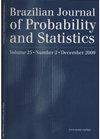多变量分布的划分
IF 0.5
4区 数学
Q4 STATISTICS & PROBABILITY
引用次数: 0
摘要
有限集合的划分是该集合的不相交和穷举子集的集合。本文研究了对多元分布进行分划所引起的分布,特别是在每个分划子集内求分划结果的分布,以及分划子集之间的分布。如果多元分布具有独立的单变量分量,则分区会导致每个分区子集内的独立单变量分量。因此,我们的注意力被吸引到没有独立单变量成分的分布上。多元正态分布通常是人们想到的第一个分布。当一个分区仅由两个子集组成时,正态分布可以划分为一个子集以另一个子集为条件,另一个子集为边缘分布。每一个都可以递归划分。然而,结果是正态密度的乘积,它显然取决于划分的顺序,尽管它实际上不能如此依赖,因为每个这样的乘积都重新表达了原始的正态多元分布。在分区中,有两种极端的情况。第一个是最粗糙的分区,包括整个空间。那么这个分划上的分布就是原来的多元分布。另一种极端情况是最好的分区,它的每个子集只有一个组件。那么这个子集上的分布取随机变量的值,其概率为1。因此,本文讨论的分区是介于两者之间的分区,既不是最粗糙的也不是最精细的。本文章由计算机程序翻译,如有差异,请以英文原文为准。
Partitioning some multivariate distributions
A partition of a finite set is a collection of disjoint and exhaustive subsets of that set. This paper concerns the distributions occasioned by partitioning a multivariate distribution, in particular to find the resultant distribution within each partition subset, and the distribution between them. If the multivariate distribution has independent univariate components, then partitioning leads to independent univariate components within each partition subset. Consequently, our attention is drawn to distributions without independent univariate components. The multivariate normal distribution is often the first such distribution that one thinks of. When a partition consists of only two subsets, the normal distribution can be partitioned into a conditional of one subset conditioned on the other, and a marginal distribution on the second subset. And each of these can be recursively partitioned. The result, however, is a product of normal densities that apparently depends on the order in which the partitioning is done, although it cannot in fact so depend, as each such product re-expresses the original normal multivariate distribution. Among partitions, there are two extreme cases. The first is the coarsest possible partition, consisting of the whole space. Then trivially the distribution over this partition is the original multivariate distribution, whatever it was. The other extreme case is a finest possible partition, each subset of which has only a single component. Then the distribution on such a subset takes the value of the random variable with probability one. So the partitions at issue in this paper are the partitions in-between, neither the coarsest nor the finest.
求助全文
通过发布文献求助,成功后即可免费获取论文全文。
去求助
来源期刊

Brazilian Journal of Probability and Statistics
STATISTICS & PROBABILITY-
CiteScore
1.60
自引率
10.00%
发文量
30
审稿时长
>12 weeks
期刊介绍:
The Brazilian Journal of Probability and Statistics aims to publish high quality research papers in applied probability, applied statistics, computational statistics, mathematical statistics, probability theory and stochastic processes.
More specifically, the following types of contributions will be considered:
(i) Original articles dealing with methodological developments, comparison of competing techniques or their computational aspects.
(ii) Original articles developing theoretical results.
(iii) Articles that contain novel applications of existing methodologies to practical problems. For these papers the focus is in the importance and originality of the applied problem, as well as, applications of the best available methodologies to solve it.
(iv) Survey articles containing a thorough coverage of topics of broad interest to probability and statistics. The journal will occasionally publish book reviews, invited papers and essays on the teaching of statistics.
 求助内容:
求助内容: 应助结果提醒方式:
应助结果提醒方式:


